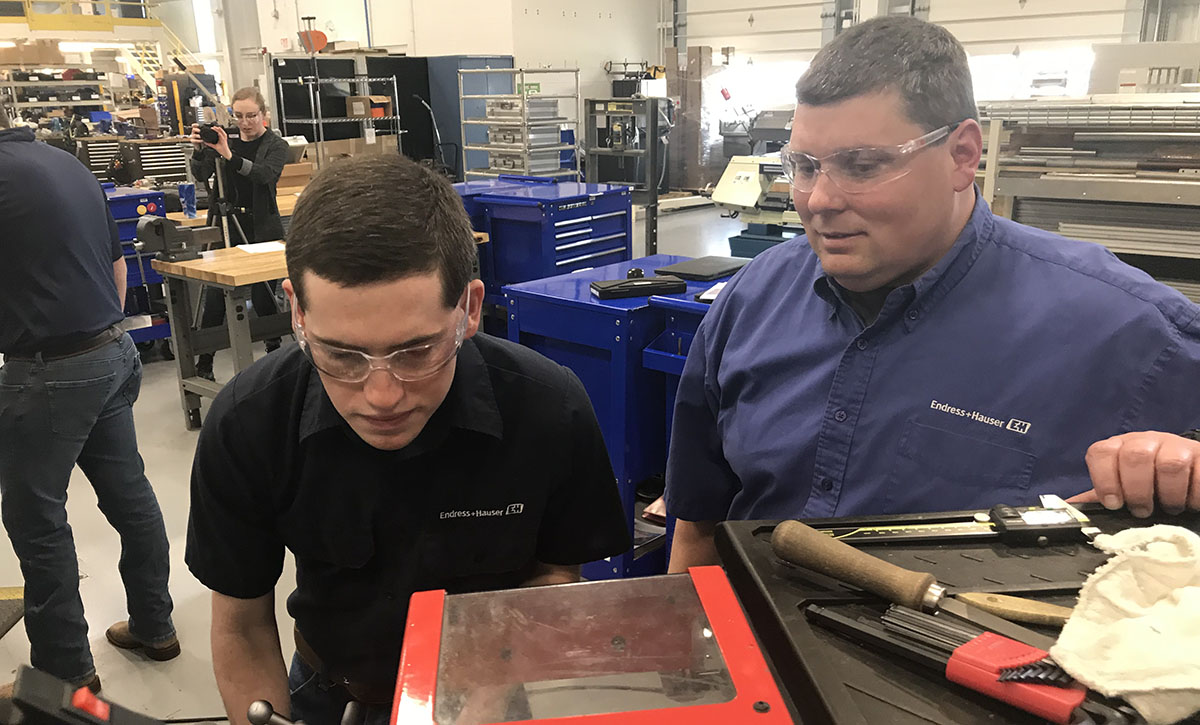Indianapolis Students Get ‘Leg Up’ On Careers With European-Style Apprenticeships
German and Swiss training inspires new apprentice programs: “We have to be a part of this.”

Get stories like this delivered straight to your inbox. Sign up for The 74 Newsletter
Job training for young people in Indianapolis is taking on a very European look.
Two growing apprenticeship programs, one German-inspired and a larger one that’s Swiss-inspired, have started in the city and its suburbs the last four years. Both pay high school and community college students to work and train for jobs in the medical, business, IT and manufacturing fields, all while still in school. The programs even cover all or part of their college tuition.
The programs differ a little in their approach and benefits to students, but both are based on a common European mindset: Students shouldn’t be left to figure out – and pay for – career training all on their own. Companies have to take some responsibility for training and supporting youth, both as a social responsibility and to develop a talent pool to hire from.
“I think Europe has a great model,” said Robert Head, the apprentice manager of the Indianapolis branch of Endress + Hauser, a Swiss and German company that makes manufacturing equipment. At the urging of the home office in Europe, his plant has brought in 17 apprentices since 2018 for advanced manufacturing technician training.
He said apprenticeships are a great way to find young employees, teach a new generation and help them find careers without massive college debt. Apprenticeships also help companies fill holes left by trained and departing employees.
“I believe they are going to catch on,” he said.
Modern Apprentice, the largest program in the city, was started as a pilot last fall after teams of business and community leaders visited Switzerland in 2019 to study the apprentice and internship system there. The three-year program puts high school students in offices of non-profits and companies like electricity provider AES Indiana and pharmaceutical company Roche their junior and senior years and for a year after. Companies pay apprentices for their work and for part of their first year of college.
The first group of 30 high school juniors started their three- year program in 16 companies last fall, and another 41 have started their program in 28 companies so far this fall. More will likely start soon. The aim is for 100 next year.
“I was pretty skeptical, heading over to Switzerland,” said Stephanie Bothun, vice president of Ascend Indiana, a workforce development non-profit and co-founder of the apprentice program.
“After going to Switzerland and talking to students, and seeing the connectivity between government, employers, associations, the school system…I came back like, we have to be a part of this. And we have to figure out how to make this a core piece of our solution.”
Jamie Wright, a recruiting leader for Roche’s U.S. operations said the company won’t use apprenticeships here as much as it does at its Basel, Switzerland, headquarters. There, a nearby apprentice training center works with 300 students a year on both business and medical skills. In Indianapolis, Roche took on four apprentices last school year to work in the finance, marketing and human resources departments, just not in research or manufacturing yet.
“We thought this would be a great opportunity to be a corporate responsible citizen and help to train the future workforce,” Wright said. “And we thought this is a great opportunity to give them exposure to different career avenues very early in your career to help them decide what’s best for them.”
Abigail Ortiz-Armado,17, who started as a Modern Apprentice in the business offices of AES last fall, said she wants to study business in college, but isn’t sure yet if she wants to do marketing or accounting. Testing different parts of the operation of AES part time, she said, will help her decide and is much better than working at Wal-Mart or McDonalds like many of her friends.
And she hopes to avoid a problem a cousin is facing – having trouble finding a job even with a college degree because she has no experience.
“This is a great opportunity for me, because I’m getting that experience already,” she said. “I’ll probably have a leg up in the game after college.”

Will Valentine, 17, a senior at North Central High School in Indianapolis, hopes to go to college and start a business someday. He jumped at a chance to be an apprentice and work part time – from 1 p.m. to 4 p.m. four days a week – for $12.50 an hour at Ascend, one of the founders of the program. He said he is using Microsoft Office programs and learning to write in a business format, as opposed to school or personal ones. He says he is telling friends to try it.
“I just saw the apprenticeship as an amazing opportunity to get, I guess, like a boost or an advantage over a lot of other kids my age,” he said. “I just think it is really preparing me for my goals.”
Both programs in Indianapolis take their lead from bigger U.S. apprentice programs that have adapted European models to America. Indianapolis Modern Apprentice has support from CareerWise, a national program that started in Colorado in 2017 and is sprouting up across the U.S., including in New York City.
CareerWise now adds close to 400 new apprentices a year in four states, plus Washington, D.C.
Endress + Hauser is part of the Industry Consortium for Advanced Technical Training (ICATT), a network of companies in eight states plus a similar program in Michigan organized by the German American Chamber of Commerce in Chicago.

Though European apprenticeships typically start at 11th grade and usually have students spend three or more years mixing work, training and school, all leading directly into full-time jobs, the adaptations here differ.
Endress and ICATT pay full community college tuition for apprentices and also pay them for 40-hour work weeks all three years, even when they are attending college a few days a week. Apprentices are expected to stay and work for two years after their three year program, so it’s a direct pipeline to work for students and the company. But it starts after high school and at community college, not in 11th grade.
“I think we are doing very well off for one reason: we’re getting our education paid for,” said Zach Speas, 23, who just finished his apprenticeship in June and is still working with the company.
He also liked being able to use skills he learned in class right away on the company production floor.
“I see myself staying here,” Speas said. “Hopefully I retire from this place. I know it’s a long way down the road, but with this company, I can see it.”
Modern Apprentice starts in 11th grade, like much of Europe, but does not guarantee a job and employers do not pay for all of college. Companies commit to paying wages, then $1,000 each of junior and senior year for specialized training or certification tests. They also contribute $4,000 toward the first year of college.
Supporters of both programs say the investment is worth it because apprentices start being real contributors to the workplace in their second and third year and reduce the need to search for new employees.
Tanya Sovinski, who heads community relations and the apprentice program in Indianapolis for AES, said recruiting and molding employees early in a tough labor market also helps.
“If we wait to get in front of talent when they’re at the end of their college career, to recruit them to join our teams, we’ve already missed the boat for potential innovative talent,” she said. “This is a way for us to try to develop a program so that we can be in front of those students as they’re thinking about their futures.”
Targeting recruiting efforts on city schools can also help businesses add diversity to their workforce, others said.
There are still challenges. Indianapolis Modern Apprentice is still a pilot program. How many apprentices stay with the companies after the three years remains to be seen. Businesses and students need to be recruited. Many need transportation help.
“We can’t be Switzerland” Bothun said, hoping to connect even a small percentage of students to work experiences. “But can we have some additional ways to bring together these two communities (business and schools) and create a positive change in momentum? Can we get to 5% or 10%?”
“That would be heroic,” she said.
This story was reported with support from the Spencer education reporting fellowship at Columbia University.
Get stories like these delivered straight to your inbox. Sign up for The 74 Newsletter

;)
